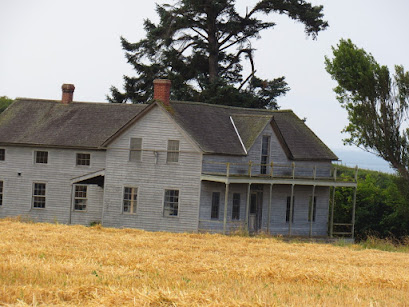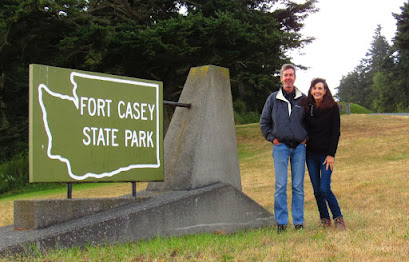A Historical Reserve & An Awesome Fort
Today found us exploring Coupeville, Washington State’s second-oldest community with much of downtown harkening back to an era of more than a century ago. Hundred-year-old buildings that were once livery stables and barber shops are now wine tasting rooms and bookstores.
This quaint town, in Penn Cove, sits in the heart of Ebey’s Landing National Historical Reserve, a place local residents and governments felt was so valuable, they formed a partnership with the National Park Service to create the reserve—the first of its kind in the U.S. (more about that below). WOW.It was also here, in a darling 1890 building that Seattle's Best Coffee was born. It began as a combination ice cream and coffee shop called the Wet Whisker in 1969. Everything starts somewhere.
The most iconic structure in town, the Coupeville Wharf on Penn Cove is a symbol of the seafaring days of old and the rural character that still surrounds it today. Today, the Wharf hosts a boat dock, a gift shop, a restaurant and a cool skeletal display of the creatures of the sea. Fun.
So this is our home for the night. Pretty sweet seaside accommodations.
We love to frolic by the sea. And it's extra sweet when you can boondock!
Boondocking is a term used by RVers to describe RVing without being connected to water, electric, or sewer. Because you're not connected to any services it's also called dry camping. Other terms you might see that all refer to boondocking are free camping and wild camping. Or sunset loving... you pick.
Moon gazing is pretty fun, too.
"... Almost a Paradise of Nature." This stunning landscape, at the gateway to Puget Sound with its rich farmland and promising seaport, lured the earliest American pioneers north of the Columbia River to Ebey’s Landing. Today Ebey’s Landing National Historical Reserve preserves the historical, agricultural and cultural traditions of both Native and Euro-American – while offering spectacular opportunities for recreation.
To continue our history lessons, we headed to Sunnyside Cemetery, a pioneer burying ground, near Coupeville. Its establishment began with the first burial, Winfield Ebey in 1865. In 1869, his sister, Mary Ebey Bozarth sold the 1.25 acre where he was buried to the county for $1.00. While there are older grave markers there, such as Rebecca Ebey, 1853, they were actually exhumed and transferred to Sunnyside. Since that time, there have been six parcels of acreage added to Sunnyside, keeping pace with Whidbey Island's expanding population.
Here lies Captain Thomas Coupe (1818 – 1875), a ship's captain and early settler of Whidbey Island.
Under the Donation Land Claim Act, Coupe established a 320-acre claim in the central part of Whidbey Island upon which the present town of Coupeville now stands.
We thoroughly enjoying touring forts and Fort Casey (began in 1897, completed in 1907) is a pretty fabulous example of American military might.Admiralty Inlet was considered so strategic to the defense of Puget Sound in the 1890s that three forts—Fort Casey on Whidbey Island, Fort Flagler on Marrowstone Island, and Fort Worden at Port Townsend—were built with the intention to create a "triangle of fire" against invading ships. This military strategy was based on the theory that the three fortresses would thwart any invasion attempt by sea.
In 1901, the big guns on disappearing carriages, which could be raised out of their protective emplacements so that the guns were exposed only long enough to fire, became active. However, the fort's batteries became obsolete almost as soon as their construction was completed.
How about these wrenches. Big toys need big tools.
Its might was short lived, however. The invention of the airplane in 1903, and the subsequent development of military aircraft, made the fort vulnerable to air attack. In addition, the development of battleships designed with increasingly accurate weaponry transformed the static strategies of the nineteenth century into the more mobile attack systems of the twentieth century.
That said, within 20 years of the first gun firing, Fort Casey was the fourth largest military post in Washington, housing 10 officers and 428 enlisted men.
We happened upon a Change of Command being conducted at the Fort. What a special treat to see today's military might.
In amongst all the concrete and steel, nature reminds us of the beauty that can be found everywhere.































0 comments:
Post a Comment